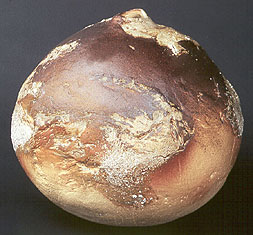Biographical Sketch
As potters, as artists, as people no matter
what we do and how we do it our work is always the product of our
cultural heritage, acquired skills, philosophical/religious
orientation, and creative vision.
I have always made (hand built) orbs, but over
time my work has changed according to these powerful
influences.
I was born into a working class family in
Germany. It was 1941 and the world was at war. My mother's relatives
were in Holland and my father was fighting in France. We lived in a
small village in the mountains, and proximity to nature was vital.
Caves served as bomb shelters and gardens provided basic nutrition.
My father survived the war but killed himself after returning home.
My mother raised me to be a competent and submissive
Hausfrau.
|

|
|
When I took my first ceramics class, I
was 28 years old, married to a master mechanic, and had two
children. The first object I made was an ashtray for my
husband the creative act a reflection of my place and
purpose in life. The second piece was a globe-like
vessel.
|
Two years later we moved to the United States.
My first sphere, a realistic representation of our globe, was made
several years later. The spatial perception was a reflection of
'being lost between two shores,' and of a desire to find and define
myself within a new culture.
While in graduate school I was 'confronting the
dilemma of self and the world.' The transition from submissive German
Hausfrau to successful professional women/artist in America was a
long and difficult one.
After graduation I worked for several years
with students suffering from drug addiction and behavioral problems
using art/clay as a therapeutic technique. When the facility closed
I traveled the US and Mexico for nearly a year in search of a new
home. If clay was not available I enjoyed
Fingerpainting.
In 1987 I joined the faculty of Duke's
Department of Psychiatry, in Durham, NC, to assist in the founding of
a substance abuse treatment program. Intense career ambition and
clinical/social service left little time and energy to work with clay
after hours. Inevitably the need to have my hands in clay became more
pressing. I build a studio onto my house, resigned from my clinical
position, and sought out opportunities to learn from renowned ceramic
artists, such as Robert Piepenburg, Paul Soldner, and Peter
Callas.

As I changed my work changed. It took on a
more global, universal character.
Back
to Index page










